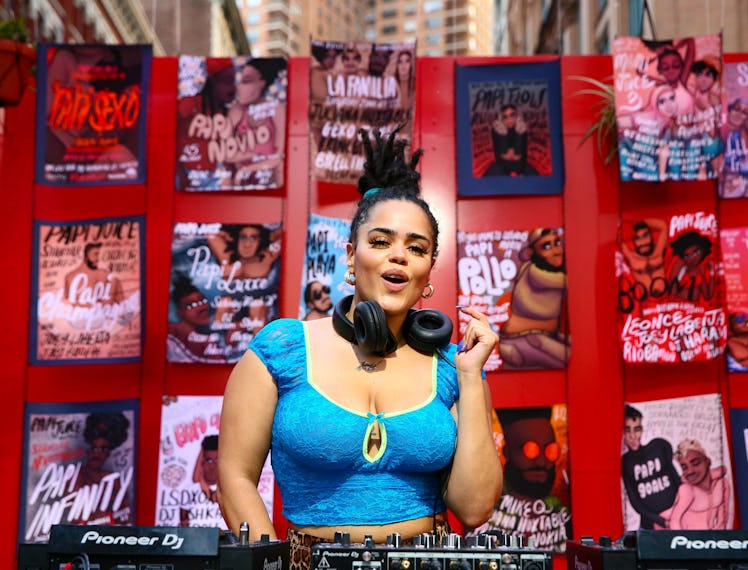Papi Juice Is the Art Collective Bringing Parties Back to Public Spaces

On Sunday, June 6, a sweltering, humid day in New York City, the artist collective Papi Juice put on their first event in over 15 months. The Brooklyn-based organization, which was founded in 2013 by resident DJs Adam R and Oscar Nuñez and art director Mohammed Fayaz, specializes in throwing decadent parties for those in the know, and carving out nightlife spaces for queer and trans people of color. Of course, once Covid hit, their events vanished. But this past weekend, Papi Juice returned for The Portal, a daytime exhibition-slash-concert-slash-performance in Manhattan—one of the first in a new project the artist Rashid Johnson is heading up with Creative Time. Called Red Stage, it’s an arena-like space right in the middle of Astor Place that will remain there through the month of June. Four weeks of artist and audience-led performances, workshops, and conversations will take place several times a week, with programming that includes a painting workshop led by Black Painters Academy, performances by New York Live Arts, and more parties thrown by the likes of the House of LaBeija and Bubble T.
For most of this weekend’s visitors, Sunday afternoon was the first time in many months anyone had gathered to listen to music and dance, or watch a live performance. Naturally, the partygoers were euphoric—hugging and kissing friends, dancing in front of the stage. The performances ran the gamut: nightlife aficionado Forrest Wu played the viola while choreographer Brandon Washington improvised a dance performance; DJ Pauli Cakes spun a mix of baile funk with her bubblegum pink Telfar bag seated on top of her deck; and the poet and performer Linda La delivered a spoken word piece on Black trans lives, to much applause and snaps of approval from the crowd. Even those who weren’t aware of the fête and had just happened to pass by Astor Place danced along to the music with glee.
Although at face value the Papi Juice takeover might have seemed like an Afropunk or Mad Decent Block Party-style outdoor concert, Nuñez and Fayaz explained in an interview a few days prior that there was plenty of artistic intention and thematic elements that went into the concept.
“Although we have gathered in the last year—for Black lives, for Asian lives, and Palestinian rights—it wasn’t necessarily for the plain and simple reason of just being together,” Nuñez said over Zoom from his home in Brooklyn. “We were thinking about what it means to gather again for the sake of gathering: What are some of the lessons that we learned in the last year, when we haven’t had this space? What are some of the things that might feel a little scary, what still brings us anxiety? What should we change?”
The answers to these questions brought Adam R, Nuñez, and Fayaz to create the portal—a liminal space between the past and the present, a sort of limbo that represents the dissociation many are experiencing as Covid numbers go down in the United States and folks return to a life of socialization. Some people might still be “behind the portal,” as Fayaz explained, wary of a potential surge in coronavirus cases, while others are “in front of the portal,” throwing themselves back into get-togethers and a pre-pandemic lifestyle.
The concept of time was key to Papi Juice’s turn on the red stage: a tight run of show schedule was ditched in favor of giving each performer a 30 minute slot to do whatever they wanted. And behind each act, an array of 72 Papi Juice fliers—which Nuñez, Adam R, and Fayaz created over the years to promote their parties—hung in chronological order.
“As this new programming is happening, right behind us—figuratively and literally—there’s our past, everything we’ve done,” Fayaz went on. “But we’re cognizant that we’re not the first people to gather queer and trans people of color; this work goes back as far as the 1920s in Harlem with the original ballroom scene and Black lesbian social clubs. We feel connected to decades and decades of this work. But while thinking backward, we also think forward: What legacy are we leaving for future queer and trans kids of color? What gems can we leave them with this organizing this work, and these mantras?”
“If there’s a pandemic in 2120, maybe kids can look at the work we did and see that there was a way through it,” he said.